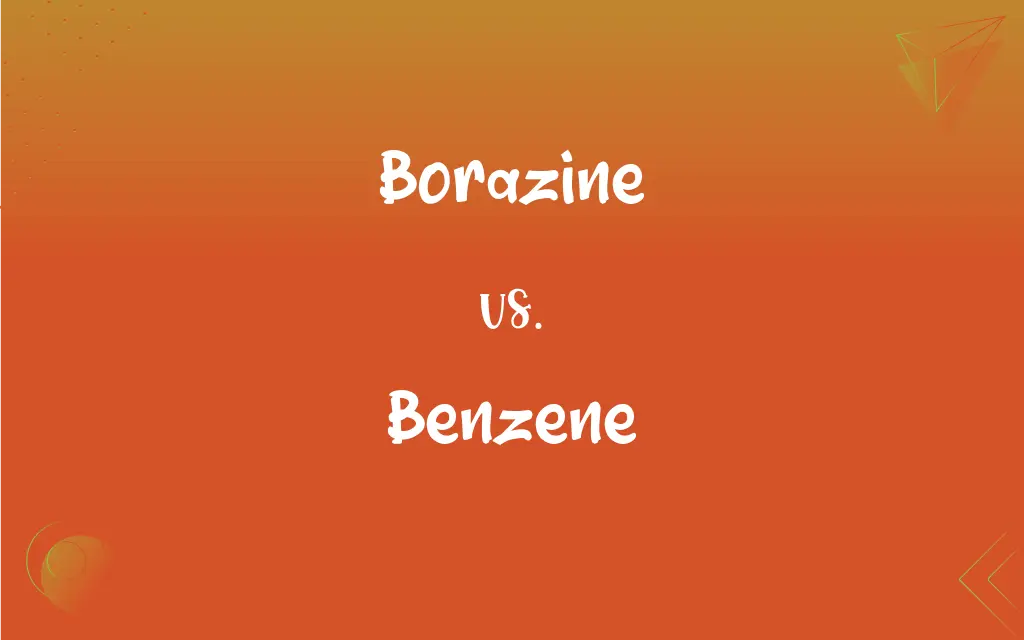Borazine vs. Benzene: What's the Difference?
Edited by Aimie Carlson || By Janet White || Published on March 3, 2024
Borazine is a cyclic compound with alternating boron and nitrogen atoms, resembling benzene's structure but with B and N atoms instead of all C atoms.

Key Differences
Borazine, also known as borazole, features a six-membered ring composed of alternating boron and nitrogen atoms. Benzene, on the other hand, is a purely carbon-based compound, with a six-membered ring of carbon atoms connected by alternating single and double bonds. This structural difference marks the fundamental distinction between these two compounds, despite their similar ring structures.
The chemical properties of borazine differ significantly from those of benzene due to the presence of boron and nitrogen atoms. Borazine exhibits some characteristics of inorganic compounds, such as forming complexes with transition metals, while benzene is a classic organic solvent known for its role in aromatic chemistry. The presence of boron and nitrogen in borazine introduces unique reactivity patterns not observed in benzene.
Borazine is often referred to as "inorganic benzene" because of its structural similarity to benzene, including delocalized π-electrons across the ring, contributing to its aromaticity. However, the aromatic stability of borazine is less than that of benzene, reflecting differences in their electronic structures. Borazine's aromaticity comes from the π-electron delocalization over B-N bonds, whereas benzene's aromaticity is due to delocalization over C-C bonds.
The physical properties of borazine and benzene also differ; borazine is a higher melting and boiling point compound compared to benzene, indicative of the stronger B-N bonding. Borazine's polar B-N bonds confer it with different solubility characteristics and reactivity compared to the nonpolar nature of benzene. These differences highlight the impact of atomic composition on the physical properties of cyclic compounds.
Despite these differences, both borazine and benzene serve important roles in their respective areas of chemistry. Borazine is used in high-temperature polymer synthesis and as a precursor for boron nitride, while benzene is a fundamental solvent and starting material in the synthesis of numerous organic compounds. The comparison between borazine and benzene illuminates the fascinating interplay between structure and properties in chemistry.
ADVERTISEMENT
Comparison Chart
Composition
Alternating boron and nitrogen atoms
Carbon atoms only
Chemical Properties
Exhibits inorganic and organic properties
Classic organic solvent
Aromatic Stability
Less stable than benzene
Highly stable aromatic compound
Physical Properties
Higher melting and boiling points
Lower melting and boiling points
Use in Chemistry
High-temperature polymers, boron nitride
Solvent, synthesis of organic compounds
ADVERTISEMENT
Borazine and Benzene Definitions
Borazine
A synthetic inorganic compound resembling benzene's ring structure.
Scientists use borazine to create advanced ceramics.
Benzene
A carcinogenic compound used in the manufacture of plastics, resins, and synthetic fibers.
Despite its hazards, benzene remains crucial in the petrochemical industry.
Borazine
Known as "inorganic benzene" for its aromatic properties despite being inorganic.
Borazine's comparison to benzene highlights its potential in chemical synthesis.
Benzene
A basic aromatic hydrocarbon with alternating double bonds.
The structure of benzene was a major discovery in the field of chemistry.
Borazine
Borazine is a compound with a hexagonal ring of alternating boron and nitrogen atoms.
Borazine's unique structure makes it a subject of interest in materials science.
Benzene
Benzene is a colorless, volatile liquid with a distinctive sweet smell.
Workers are advised to handle benzene with care due to its toxicity.
Borazine
A precursor in the synthesis of boron nitride materials.
The production of boron nitride coatings often starts with borazine.
Benzene
Benzene is an organic compound with a six-membered ring of carbon atoms.
Benzene is a fundamental solvent in organic chemistry.
Borazine
Borazine exhibits both organic and inorganic chemical behavior.
The dual nature of borazine broadens its applicability in research.
Benzene
Known for its role in the synthesis of numerous organic compounds.
Many pharmaceuticals are synthesized using benzene as a starting material.
Borazine
(inorganic compound) A cyclic hydride of boron and nitrogen made by the reaction of diborane and ammonia; it is isoelectronic with benzene.
Benzene
A colorless, flammable, toxic, liquid aromatic hydrocarbon, C6H6, derived from petroleum and used in or to manufacture a wide variety of chemical products, including DDT, detergents, insecticides, and motor fuels. Also called benzol.
Benzene
(organic compound) An aromatic hydrocarbon of formula C6H6 whose structure consists of a ring of alternate single and double bonds.
Benzene
Sometimes used in place of the phenyl group.
Benzene
A volatile, very inflammable liquid, C6H6, contained in the naphtha produced by the destructive distillation of coal, from which it is separated by fractional distillation. The name is sometimes applied also to the impure commercial product or benzole, and also, but rarely, to a similar mixed product of petroleum.
Benzene
A colorless liquid hydrocarbon; highly inflammable; carcinogenic; the simplest of the aromatic compounds
FAQs
What is borazine?
A compound with alternating boron and nitrogen atoms, resembling the structure of benzene.
What is benzene?
An organic compound consisting of a six-membered carbon ring with alternating double bonds.
How do borazine and benzene differ in composition?
Borazine contains boron and nitrogen, while benzene is composed of carbon atoms only.
Are both borazine and benzene aromatic?
Yes, both exhibit aromaticity, but due to different electronic structures.
Which has higher thermal stability, borazine or benzene?
Benzene generally exhibits greater thermal stability compared to borazine.
What makes borazine unique in materials science?
Its structure and properties make it a precursor for advanced materials like boron nitride.
How does the presence of B-N bonds in borazine affect its properties?
The B-N bonds introduce polarity and different chemical reactivity compared to benzene's nonpolar C-C bonds.
Why is benzene considered hazardous?
Benzene is carcinogenic and can cause serious health issues upon exposure.
Is borazine naturally occurring?
No, borazine is synthetically produced in laboratories.
How is borazine synthesized?
Through reactions involving boron trichloride and ammonia or similar compounds.
What role does benzene play in industry?
It's used as a solvent and in the synthesis of plastics, resins, and synthetic fibers.
What are the uses of borazine in high-temperature applications?
It's used in the creation of high-temperature polymers and coatings.
How does benzene's aromaticity compare to borazine's?
Benzene's aromaticity is more stable due to its fully carbon-based ring.
What advancements have borazine contributed to in materials science?
It has enabled the development of novel ceramics and boron nitride materials.
Can borazine be used in organic synthesis like benzene?
Borazine is more niche, used mainly in high-temperature materials and ceramics, unlike benzene's broad use in organic synthesis.
What are the safety measures for handling benzene?
Use in well-ventilated areas, wear protective equipment, and avoid inhalation or skin contact.
Can benzene and borazine be used interchangeably in reactions?
No, their differing reactivities and properties mean they are used in distinct applications.
Can borazine act as a solvent like benzene?
Its use as a solvent is limited due to its reactivity and higher boiling point.
What are the environmental concerns associated with benzene?
Benzene's volatility and toxicity raise concerns about air and water pollution.
What is the significance of benzene in organic chemistry?
Its structure and reactivity make it a cornerstone for understanding aromatic compounds and synthesizing a wide range of chemicals.
About Author
Written by
Janet WhiteJanet White has been an esteemed writer and blogger for Difference Wiki. Holding a Master's degree in Science and Medical Journalism from the prestigious Boston University, she has consistently demonstrated her expertise and passion for her field. When she's not immersed in her work, Janet relishes her time exercising, delving into a good book, and cherishing moments with friends and family.
Edited by
Aimie CarlsonAimie Carlson, holding a master's degree in English literature, is a fervent English language enthusiast. She lends her writing talents to Difference Wiki, a prominent website that specializes in comparisons, offering readers insightful analyses that both captivate and inform.
































































